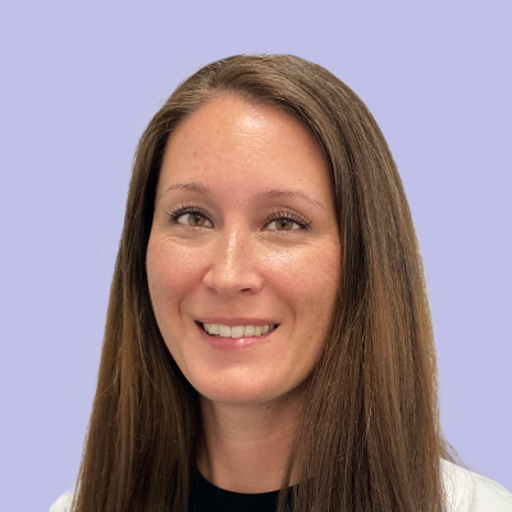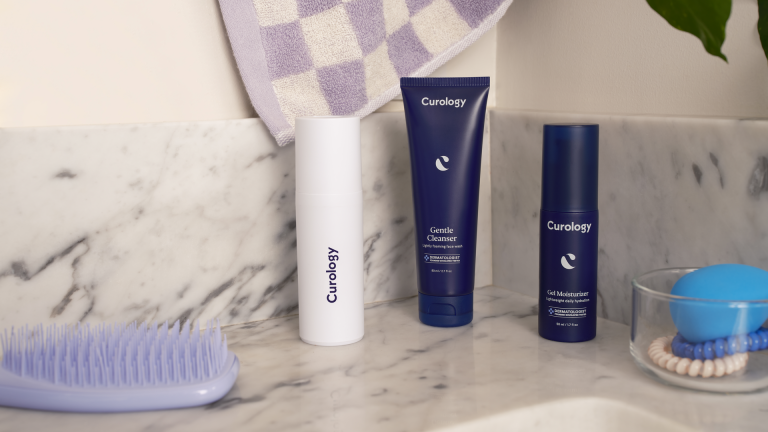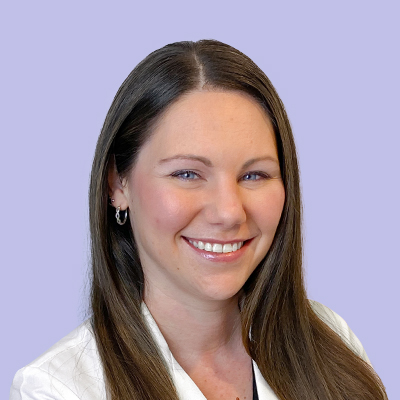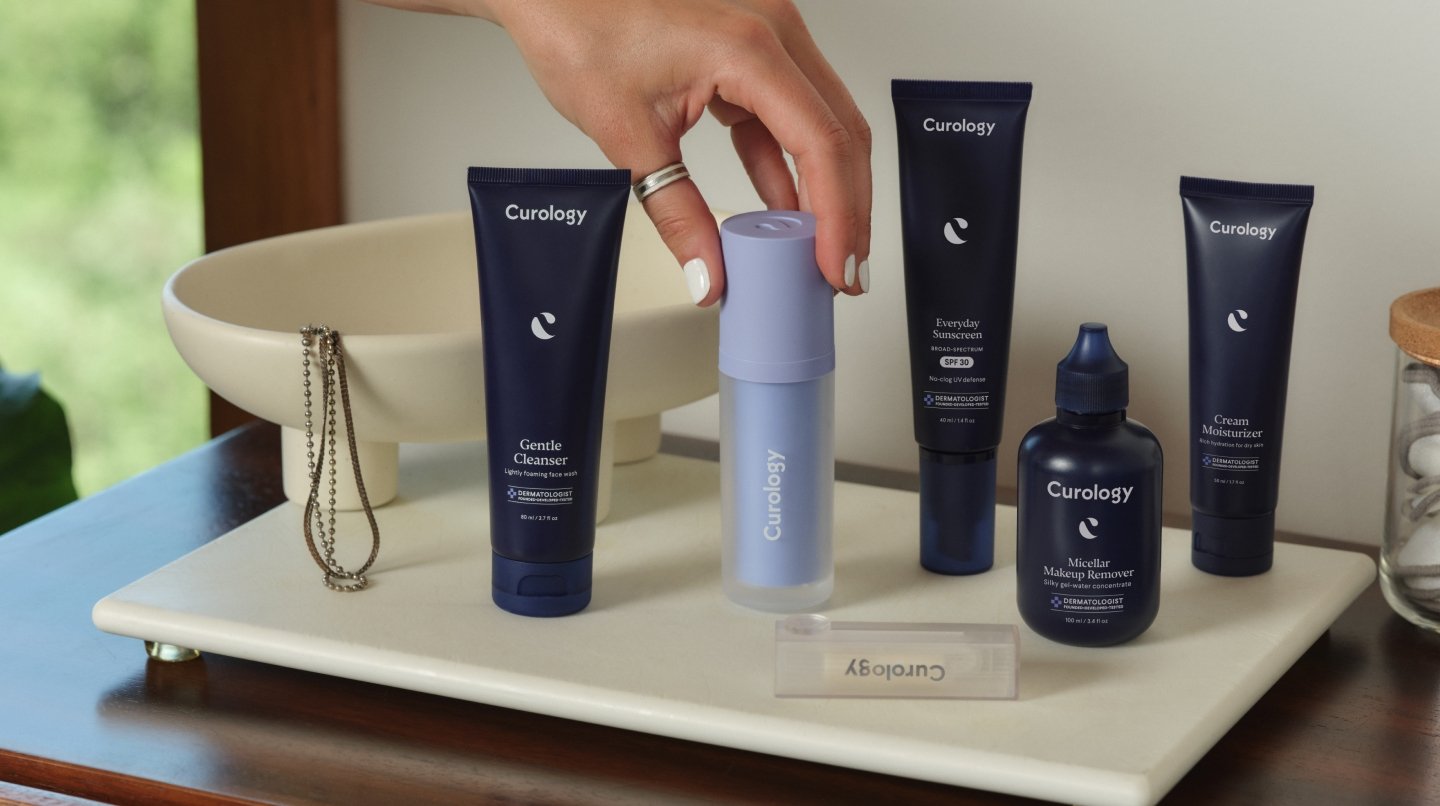How it works:
Share your skin goals and snap selfies
Your dermatology provider prescribes your formula
Apply nightly for happy, healthy skin
How it works:
How it works:
Share your skin goals and snap selfies
Your dermatology provider prescribes your formula
Apply nightly for happy, healthy skin
How it works:
Ask an expert: How to get rid of rosacea permanently
Spoiler alert: You can’t. But there are effective ways to prevent flare-ups.





In this article
Rosy cheeks might not seem like such a big deal when you’re blushing. But that’s not necessarily the case when it’s because of rosacea. Rosacea is a chronic skin condition that most often causes redness and flushing across the nose, cheeks, and forehead, and there’s no cure for it. (Yet!) So, if you’re wondering how to remove rosacea permanently—unfortunately, you can’t. But there are steps you can take to help prevent and minimize rosacea flare-ups when they happen. Our team of licensed dermatology professionals at Curology specializes in helping patients manage rosacea symptoms effectively.
The key takeaways
While there’s no permanent cure for rosacea, understanding and managing its triggers can reduce flare-ups and enhance skin health.
For rosacea management, topical medications like azelaic acid, metronidazole, and ivermectin can reduce redness and acne-like lesions, while laser therapies may help minimize visible blood vessels.¹
Embracing a balanced diet, practicing regular exercise, reducing alcohol consumption, quitting smoking, and managing stress are certain lifestyle adjustments that may help to prevent rosacea flare-ups.
Leaving rosacea untreated can escalate your symptoms, making them more noticeable and severe. This can lead to more persistent symptoms, eye issues, and skin thickening (like rhinophyma).
Regular consultations with dermatology experts can help tailor treatments, and monitor your progress so you can adjust as needed.
Calm your rosacea with a custom formula. Start today.
Calm your rosacea with a custom formula. Start today.


What is rosacea, and what are the key symptoms?
Rosacea isn’t just a case of sensitive skin; it’s a common chronic inflammatory skin condition.
Its symptoms may include some or all of the following:²
Redness or flushing (that may intensify periodically).
Visible small blood vessels on your face.
Red bumps and pus-filled spots on your nose, chin, cheeks, and forehead.
Skin thickening, especially on your nose (rhinophyma). This can also affect your cheeks and chin.
Apart from the above symptoms, rosacea can also have a psychological impact. The condition can be linked to anxiety, embarrassment, and depression,³ significantly impacting quality of life. Some studies also associate rosacea with neurologic diseases, inflammatory bowel disease, and cardiovascular diseases.⁴
Now, you might be wondering, is itchy skin a symptom of rosacea? Not always. If you’re experiencing itchy skin, it could be dry skin or potentially a condition like eczema⁵ or psoriasis.⁶ For this reason, it is always best to consult with a dermatology expert to receive a proper diagnosis.
For those with rosacea, you may want to consider a personalized formula at Curology! By consulting with one of our dermatology providers, you may be prescribed a personalized formula tailored to your skin goals and needs, ensuring you’re on the right track to achieving optimal skin health. Additionally, you can learn more about rosacea care options in our guide to rosacea.
Does rosacea go away over time?
Rosacea is generally a lifelong condition, so, unfortunately, no. That’s why it is important to learn to manage it by avoiding triggers and following your treatment plan.
You can also be proactive by dedicating yourself to a healthy skincare routine:
Cleanse. Wash your face in the morning and at night using a gentle cleanser for sensitive skin.
Moisturize. Help minimize irritation by keeping your skin moisturized. Be sure to choose a moisturizer that’s designed for your skin type.
Apply sunscreen. Apply a broad spectrum sunscreen every day (and reapply as needed!).
One thing you shouldn’t do is ignore your rosacea. Without management, it can worsen.
Before we dive into treatment options and management, it’s helpful to understand the different types and causes of rosacea that influence treatment.

Types of rosacea
Rosacea has different subtypes. Let’s explore them a bit more to understand the condition better:⁷
Vascular rosacea
Characterized mainly by facial redness and flushing, vascular rosacea, may also showcase visible blood vessels. This subtype lays the groundwork for understanding rosacea’s manifestations, paving the way to its second subtype, inflammatory rosacea.
Inflammatory rosacea
Inflammatory rosacea presents with red bumps and white heads. These pus-filled blemishes, accompanied by red, swollen bumps, predominantly appear on the cheeks, chin, and forehead. Often mistaken for acne, its presentation also includes facial redness and flushing.
Phymatous rosacea
Phymatous rosacea is marked by skin thickening, especially noticeable on the nose. This thickening results in a bumpy texture, and in severe manifestations, can be linked to rhinophyma, a more pronounced symptom.
Ocular rosacea
A unique subtype, ocular rosacea, influences the eyes. 50-75% of rosacea patients may have ocular rosacea eye symptoms, which include dryness, redness, tearing, and blurred vision.⁸
So, there you have it—a brief tour through the diverse world of rosacea. Recognizing its many shades empowers us to approach treatments with more precision.
But what exactly causes rosacea? Let’s get into it.
What is the root cause of rosacea?
Rosacea is not a one-size-fits-all common skin condition.
Experts are still unable to fully answer the question: What is the leading cause of rosacea? However, we know that it’s a multifaceted condition potentially linked to genetics, an overactive immune system, skin mites (Demodex folliculorum), and intestinal bacteria (Helicobacter pylori).⁹
The good news is that treatment outcomes are promising, with options focusing on controlling rosacea symptoms and avoiding triggers. Often, this includes a combination of lifestyle changes, diligent skincare, and medications.
What are some of the best ways to treat rosacea?
The best treatment of rosacea is the treatment that works for you. We know it may sound overly simple or cliché, but it’s true. Treatment will depend on the specific symptoms you’re experiencing, which may include persistent redness, flushing or blushing, acne-like lesions (pustules and papules), and dilated or visible blood vessels (telangiectasias).¹⁰
With its myriad of symptoms, rosacea often requires a multi-faceted approach for effective management. Family nurse practitioner Erin Pate explains:
“...Incorporating a sulfur soap (as long as there are no allergies) into your skincare routine can be helpful along with topical prescriptions like ivermectin, metronidazole, and azelaic acid.”
There are several treatment options available and your dermatology provider can help guide you in the best treatment for your specific symptoms.
Connect with a rosacea specialist to get your custom treatment.
Connect with a rosacea specialist to get your custom treatment.


What clears rosacea fast?
You can help treat your rosacea in several ways, from personalized medication to home remedies.
Let’s take a closer look at the current treatments available.
Manage with personalized treatment plans
When it comes to the treatment of rosacea, several topical medications have gained the FDA’s seal of approval. Among these, azelaic acid, metronidazole, and ivermectin stand out for their efficacy in treating rosacea symptoms.¹¹ These active ingredients help to reduce inflammation, redness, and the breakout-like symptoms that rosacea can cause.
Oral antibiotics (like doxycycline and azithromycin) are also an option,¹² but they’re usually seen as a short-term solution for rosacea flares. The primary role of these antibiotic treatments is helping to reduce inflammation.¹³
Given the complexity and uniqueness of every individual’s skin, it's paramount to prioritize personalized treatment plans. Regular check-ins with a dermatology provider help monitor progress and fine-tune the treatment to best suit the evolving needs of your skin.
That’s why direct messaging with one of our dedicated dermatology providers is part of all our prescription formulas. It’s always beneficial to work hand in hand with a seasoned expert, ensuring your rosacea skincare regime is on point.
Soothe rosacea with light therapy
Laser and light therapies are another possible treatment of rosacea.
The Pulse-dye laser, or PDL for short, is especially great at reducing redness on the face. After just two sessions, many people with rosacea see improvement in their skin, and experience reduction in burning and itching. But PDL can sometimes cause side effects like discomfort and maybe even bruising,¹⁴ so be sure to discuss the risks with the medical provider performing the treatment.
Another option is Intense Pulsed Light (IPL). Think of it as an intense flashlight for your skin. In some tests, IPL gave results as good as, if not better, than PDL. The bonus? Fewer side effects!¹⁵
So, if you're bothered by facial redness due to rosacea, both PDL and IPL may be an effective treatment and your ticket to more comfortable skin.
Help calm rosacea with herbal remedies.
Natural remedies may be a viable option if you’re looking beyond prescriptions to calm your persistent facial redness.
Some of the herbal remedies include:¹⁶
Green tea: Green tea, made from Camellia sinensis leaves, is filled with antioxidants like epigallocatechin gallate (EGCG). Sun often triggers rosacea, so green tea might reduce redness associated with UV exposure.
Licorice root: The root contains an ingredient named licochalcone A. This has been found to help reduce redness seen in rosacea. When combined with certain other elements, it may help to soothe sensitive skin prone to redness, giving a calming effect.
Bitter wood (Simarouba amara): Extracts from this plant have shown potential in reducing visible blood vessels, or telangiectasia, in rosacea. In studies, using a gel made from this extract significantly improved rosacea symptoms over a few weeks.
It’s important to remember that while these remedies can offer relief for some, not all might suit every individual. Always speak with a dermatology professional first to know what treatment is right for you.
So, what is the best solution for rosacea?
Let’s cut to the chase: What helps rosacea?
Our medical experts emphasize the importance of managing triggers like heat, alcohol, and spicy foods.
“Managing triggers can be very helpful! Some common triggers include heat, alcohol, spicy food, skincare products, stress, and sun exposure.” Erin Pate, FNP-BC.
Aside from managing triggers, treatments range from topical medications like azelaic acid to oral antibiotics and advanced procedures like Pulse-dye laser (PDL). Natural remedies, such as green tea, may offer relief, but use with the approval of your dermatology provider. Effective rosacea management is about personalized treatment, and connecting with dermatology experts is crucial.
So, what is the best treatment of rosacea? It’s the one tailored to you! From the prescribed treatments to lifestyle adaptations, a comprehensive approach often yields the best results.
How to prevent rosacea flare-ups
One of the most pressing questions for those dealing with rosacea is, “How can I keep from having rosacea again?”. It's a valid concern given the cyclical nature of the condition. The answer lies in medical treatments and your daily habits and lifestyle choices.
Taking the reins on your lifestyle can substantially influence the frequency and severity of rosacea flare-ups.
Here’s a few factors that can play a role in flare-ups:
Dietary choices: That spicy taco or the glass of wine on a Friday night might be a treat for you, but they can also be potential triggers for rosacea.¹⁷ Listening to your body and noting how it reacts post-consumption can guide you on what to avoid.
Sun protection: A golden rule for all but especially crucial for rosacea sufferers. Regularly applying a broad-spectrum sunscreen, even on cloudy days, can help prevent flare-ups.¹⁸
Stress management: We all experience stress, but for some, stress can result in a rosacea flare-up. Simple techniques like deep breathing, meditation, or brisk walking can be effective stress-busters.¹⁹
Erin Pate, FNP-BC, underscores the importance of personalized care. She advises, “Avoid personal triggers like sun exposure, heat, certain skincare products, and stress. Recognizing your triggers and steering clear of them can make a world of difference. Remember, a gentle skincare regimen is key, as many with rosacea often have sensitive skin.”
In essence, while medications and treatments play their part, small daily choices often form the frontline defense against rosacea flare-ups. Making informed lifestyle adjustments, in harmony with medical advice, can pave the way for healthier skin days.
Avoid your rosacea triggers
Living with rosacea often feels like navigating a tricky maze, dodging various flare-up triggers. These triggers can vary from person to person, but knowing the common ones is half the battle won.
Here are some usual culprits to keep in mind:²⁰
Beverages: Be cautious with hot drinks and alcohol—especially red wine, beer, and spirits.
Food: Certain foods, including spicy delights, yogurt, chocolate, and citrus fruits might ignite rosacea in some individuals.
Emotional factors: Intense emotions and stress can be triggering.
Skincare: Some products containing ingredients like alcohol, witch hazel, or fragrances might not sit well with rosacea-prone skin. Make sure you follow a gentle skin care routine.
Environmental factors: Extreme temperatures, whether they’re hot or cold, alongside sun exposure, wind, or humidity, can provoke flare-ups.
Physical activity: Intense workouts might cause more than just sweat; they can trigger rosacea too.
This list covers many potential triggers, but individual experiences vary. Understanding and recognizing your individual triggers is an important step in managing rosacea.
Learn more about the most common rosacea triggers in this dedicated article on our blog.
How do I control my rosacea naturally? Lifestyle changes that can help with rosacea
Rosacea can affect anyone, but research shows other factors may increase a person’s chances of having it. According to a 2017 Journal of the American Academy of Dermatology study, there may be a link between obesity and rosacea.²¹ At Curology, we encourage a healthy lifestyle that includes eating a well balanced diet. But diet isn’t everything. And the AAD agrees.²² Here are a few other recommendations:
Eat a healthy and balanced diet, including fresh vegetables, fruit, whole grains, legumes, and lean proteins. Studies suggest eating to promote a healthy gut microbiome and fiber-rich foods.²³
To help control your rosacea naturally:
Exercise regularly—daily, ideally. Although exercising may trigger rosacea, it can help you maintain a healthy weight. Monitor your symptoms and adjust the intensity your workouts, if needed.²⁴
Limit alcohol. Alcohol can be a trigger for rosacea and other health risks.
Don’t smoke. There are plenty of reasons to skip smoking, including rosacea. If you’re a smoker who still hasn’t kicked the habit, it’s time to call it quits.
Reduce stress through meditation, yoga, or other stress-reduction strategies. The National Rosacea Society found that almost 70% of 748 people surveyed said they could reduce their flare-ups by managing stress.²⁵
Treat your symptoms using topical medications, following a skincare plan that works for you, and watching out for your triggers. This can help prevent your rosacea from progressing. If symptoms seem to last longer, consider seeking help from a dermatology expert, or trying our custom rosacea treatment.
Prioritize sunscreen. Choose broad-spectrum, high SPF sunscreens and reapply every 2 hours when outside. Protecting your skin from harmful UV rays is essential for rosacea management.
Remember, every individual’s journey with rosacea is unique. If symptoms persist or worsen, consult a dermatology expert or explore our tailored rosacea treatments. Want more insights? Dive deeper and discover firsthand experiences in what dermatology providers do for their rosacea.
What happens if rosacea goes untreated?
Many people delay rosacea treatment or go undiagnosed. If left untreated, the symptoms can become persistent with the risk of permanent scarring.²⁶ Aside from redness and blushing, ocular rosacea may develop, causing your eyes to become red and dry, impairing your vision.²⁷ Phymatous changes are rare but can result from untreated rosacea. It is thickened skin, most commonly seen on the nose (rhinophyma) and surrounding skin. In some instances, it may impair breathing.²⁸
According to the American Academy of Dermatology (AAD), rosacea symptoms can become more noticeable if left untreated. This includes long-lasting flushing and permanent redness. Visible blood vessels can appear on your cheeks, and some people may develop acne-like lesions.²⁹ (Speaking of acne-like pimples… Can you pop rosacea bumps? You can, but that doesn’t mean you should. Picking and popping can lead to permanent scarring. So please don’t do it!)
Several studies show a correlation between rosacea and other diseases, like diabetes, heart disease, Alzheimer’s, Crohn’s, and migraine headaches. However, the AAD cautions that more research is needed before we can say with certainty that rosacea increases the risk of getting these diseases.³⁰
Rosacea’s impact: Beyond skin deep
Living with rosacea isn’t just about managing redness or visible blood vessels. The emotional toll of untreated rosacea can be profound, affecting self-esteem and confidence. Continuous flare-ups can lead to anxiety and embarrassment,³¹ prompting some to avoid social interactions.
As the condition progresses, the threat of permanent changes, like facial skin thickening or potential vision issues, intensifies these feelings. While some studies suggest links between rosacea and conditions like diabetes or heart disease, more research is needed.
However, the looming uncertainty can be anxiety-inducing. The upside? Timely treatment does more than clear the skin; it renews confidence and overall well-being. Addressing rosacea isn’t just a matter of skincare but of holistic health and emotional renewal.
Curology can help you treat symptoms of rosacea
When caring for your skin, we’re here to help. Curology was founded in 2014 by Dr. David Lortscher, MD, a board-certified dermatologist. Curology is dedicated to providing affordable customized solutions for our members that deliver potent results.
We can help treat rosacea with ingredients such as ivermectin, metronidazole, and azelaic acid. These ingredients are used to create a personalized formula prescribed by one of our licensed in-house dermatology providers. We work with our members to find solutions to meet their skincare goals.
Not yet a Curology member? Signing up is simple. Answer a short questionnaire and snap a few selfies to help us get to know your unique skin. If Curology suits you, we’ll pair you with one of our licensed dermatology experts, who will design a personalized rosacea formula* and guide you in your skincare journey.
FAQs
Rosacea has various types, each presenting with distinct characteristics. Three of them are:
Type 1—Vascular Rosacea: This type is identified by red areas on the face. Upon closer inspection, small blood vessels become more visible on the skin.
Type 2—Inflammatory Rosacea: Alongside facial redness, you’ll encounter red bumps or pimples; some might even evolve into pus-filled spots or blemishes.
Type 3—Phymatous Rosacea: The skin begins to thicken, taking on a bumpy texture. The most common area this type affects is the nose, which can become prominently enlarged and bulbous.
Determining your rosacea type can help tailor treatment more effectively. Consult a dermatology professional for a precise diagnosis and appropriate care.
The first step in treatment is understanding and avoiding personal triggers to help reduce the frequency and severity of flare-ups. For persistent redness, topical medications like azelaic acid, metronidazole, and ivermectin may help control symptoms.
Erin Pate, FNP-BC, sheds light on this: “Dermatology providers can help patients manage rosacea with topical prescriptions like ivermectin, metronidazole, and azelaic acid. Helping patients learn how to manage their triggers, as everyone’s a little bit different, can make a big difference. Knowledge is power!” Dermatology providers bring their expertise to recommend tailored treatments, provide guidance on skincare routines, and help patients navigate the intricacies of rosacea for better skin health.
Rosacea is a chronic condition with recurrent symptoms that vary among individuals. While some might experience quick relief with topical treatments, others might need more intervention to help control symptoms. Consistent treatment and trigger management can significantly reduce symptoms.
There isn’t conclusive evidence to label rosacea as an autoimmune disorder. However, rosacea can be linked to immune system activation.³²
Natural treatments like a balanced diet and stress reduction can help manage symptoms. But for more detailed guidance on a natural approach, check out this article by a dermatology expert: How I manage my rosacea.
Certain makeup products can camouflage rosacea redness. It’s essential to choose non-irritating, hypoallergenic products. For more makeup tips tailored for rosacea, dive into this handy guide.
Managing triggers, adopting a tailored skincare routine, and consulting dermatology experts can be your best defense against recurrent flare-ups. For a more comprehensive strategy and long-term results, combine lifestyle optimization with custom treatment.
It’s essential to understand that while rosacea’s symptoms can be managed effectively, it isn’t “cured” traditionally. Consistent treatment, understanding triggers, and adapting a holistic approach are pivotal for long-term management.
P.S. We did the homework so you don’t have to:
Farshchian, M. and Daveluy, S. Rosacea. StatPearls. (2023, August 8).
Farshchian, M. and Daveluy, S. Rosacea. StatPearls. Ibid.
Farshchian, M. and Daveluy, S. Rosacea. StatPearls. Ibid.
Farshchian, M. and Daveluy, S. Rosacea. StatPearls. Ibid.
Nemeth, V. and Evans, J. Eczema. StatPearls. (2022, August 8).
Nair, P.A. and Badri, T. Psoriasis. StatPearls. (2023, April 3).
Institute for Quality and Efficiency in Health Care (IQWiG). Rosacea: Overview. InformedHealth.org. (2020, September 10).
Farshchian, M. and Daveluy, S. Rosacea. StatPearls. Ibid.
Farshchian, M. and Daveluy, S. Rosacea. StatPearls. Ibid.
Farshchian, M. and Daveluy, S. Rosacea. StatPearls. Ibid.
Institute for Quality and Efficiency in Health Care (IQWiG). Rosacea: Overview. InformedHealth.org. Ibid.
Farshchian, M. and Daveluy, S. Rosacea. StatPearls. Ibid.
Institute for Quality and Efficiency in Health Care (IQWiG). Rosacea: Overview. InformedHealth.org. Ibid.
Engin, B., et al. Conventional and Novel Treatment Modalities in Rosacea. Clin Cosmet Investig Dermatol. (2020, February 20).
Engin, B. et al. Conventional and Novel Treatment Modalities in Rosacea. Clin Cosmet Investig Dermatol. Ibid.
Hoffmann, J., et al. New Herbal Biomedicines for the Topical Treatment of Dermatological Disorders. Biomedicines. (2020, February 8).
American Academy of Dermatology Association. Triggers Could Be Causing Your Rosacea Flare-Ups. (n.d.).
American Academy of Dermatology Association. 6 Rosacea Skin Care Tips Dermatologists Give Their Patients. Ibid.
American Academy of Dermatology Association. How to Prevent Rosacea Flare-ups. (n.d.).
American Academy of Dermatology Association. How to Prevent Rosacea Flare-ups. Ibid.
Li, S., et al. Obesity and risk for incident rosacea in US women. Journal of the American Academy of Dermatology. (December 2017).
American Academy of Dermatology Association. Living with rosacea? How to reduce your risk of other conditions. (n.d.).
Weiss, E. and Katta, R. Diet and rosacea: the role of dietary change in the management of rosacea. (2017, October 31).
American Academy of Dermatology Association. Living with rosacea? How to reduce your risk of other conditions. (n.d.).
The National Rosacea Society. Survey Shows Controlling Stress Can Reduce Flare-Up Frequency. Rosacea Review. (Fall 2011).
Farshchian, M. and Daveluy, S. Rosacea. StatPearls. Ibid.
Institute for Quality and Efficiency in Health Care (IQWiG). Rosacea: Overview. InformedHealth.org. (2020, September 10).
Gupta, M., et al.Severe rhinophyma treated by shave excision and electrocautery. BMJ Case Rep. (2020, January 13)
American Academy of Dermatology Association. Do You Have to Treat Rosacea?. (n.d.).
American Academy of Dermatology Association. Living with rosacea? How to reduce your risk of other conditions. Ibid.
Farshchian, M. and Daveluy, S. Rosacea. StatPearls. Ibid.
Farshchian, M. and Daveluy, S. Rosacea. StatPearls. Ibid.
*Cancel anytime. Subject to consultation. Results may vary.
Kristen Jokela is a certified Family Nurse Practitioner at Curology. She obtained her Master of Science in Nursing at the University of South Florida in Tampa, FL. Erin Pate is a board-certified Family Nurse Practitioner at Curology. She earned her Masters of Science in Nursing at Florida Atlantic University in Boca Raton, FL.

Curology Team

Kristen Jokela, NP-C
Related Articles
Men skin care: top concernsFace sunscreen for sensitive skinSunscreen for eyes: How to protect your delicate skin from UV raysYour first weeks on CurologyWhat should your underarm care routine look like?Popular Articles
Ask Curology: Is my cold breaking me out?Slugging: The dermatologist-approved skincare hack going viral on TikTokTretinoin vs retinol: What’s the difference?How to create a self-care routine that actually sticksYour 2023 skincare horoscopeTry prescription skincare
Get routine essentials

Good skin days ahead
- Breakouts
- Redness
- Fine lines
- Dark spots
- Hair thinning